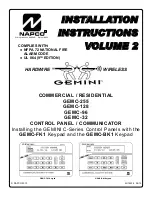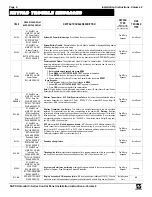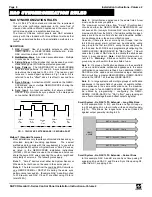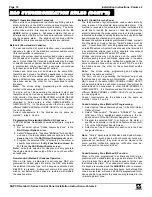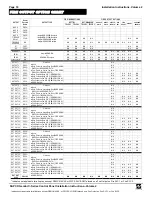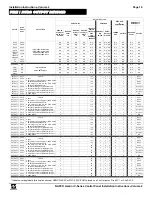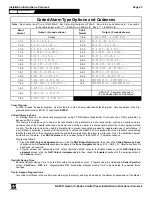
NAPCO Gemini C-Series Control Panel Installation Instructions--Volume 2
Installation Instructions, Volume 2 Page 13
satisfied with an EOLR device or the zone will remain faulted, preventing point devices to be mapped to the associ-
ated zone. The system must not possess overlapping EZM addresses, even if used on separate buses (Fire or Bur-
glary).
The Fire GEMC-EZM8 must be wired to the motherboard Fire bus with all zones hardwired to listed Fire initiating de-
vices or listed Burglary devices suitable for the application. Only Fire devices may be wired to any Fire GEMC-EZM8
zone. Fire devices are all normally open and require parallel, daisy chain wiring with the end of line device on the last
device to properly supervise the loop for opens that prevent the initiation of an alarm. Any power needed to power a
device on the loop should only be provided from either the motherboard, or an UL 1481 listed power supply suitable
for the application and monitored by two Fire "Monitor" zones on the Fire system for AC fail and Battery Trouble.
Power from the GEMC-BM, GEMC-BM/PS or any power supply not monitored by Fire zones should not be used on
any Fire device, as a fault on the non-Fire device may affect the operation of the Fire system.
A Burg GEMC-EZM8 must be wired to the Burglary bus of the GEMC-BM, or GEMC-BM/PS. No Fire devices may be
wired to a Burg GEMC-EZM8, as a fault on the Burglary bus would affect the operation of the Fire system.
On the Burglary Bus, GEMC-BK1 keypads can also be configured to support a single 4-zone Burglary EZM, wired to
the associated flying leads.
Burg GEMC-EZM8 zones must be in groups of 4 or 8 zones, and must be wired to an associated GEMC-EZM8 or
GEMC-BK1 that in turn is wired to the Burg bus on either the Burg Module, the GEMC-BM or the GEMC-BM/PS.
WIRELESS TRANSMITTER POINTS
Wireless Transmitter Points are wireless initiating devices that transmit alarm, supervision and low battery conditions
to the C-Series Control Panel through at least one (and up to four) GEMC-RECV wireless receivers wired to a remote
bus. Each point must be mapped to a specific, exclusive zone with no other devices on the same zone.
Fire Wireless transmitter points require all GEMC-RECV wireless receivers to be wired to the Fire bus of the mother-
board, preventing faults on the Burg bus from affecting the Fire system operation. These may be mapped to any of
the 255 zones. Only the GEMC-WL-SMK, GEMC-WL-HEAT and the GEMC-WL-WD2 are listed as commercial wire-
less Fire initiating devices with the Gemini C-Series control panel.
Burg Wireless transmitter points require at least one GEMC-RECV on the system. In a Burg-Only system, the receiv-
ers may be placed on the Burg bus; otherwise all receivers must be placed on the Fire bus.
FIRE SLC POINTS
Fire SLC points are Fire initiating devices that transmit Fire alarm conditions through a GEMC-FW-SLC Fire SLC
Module to the Gemini C-Series control panel. This module also monitors the devices and will generate a supervision
trouble to the panel if a device does not respond within 200 seconds (see
Zone Identification with SLC Point Trou-
bles
, below). Each point must be mapped to a specific, exclusive zone with no other devices on the same zone. The
zones can overlap existing EZM zones, if the zone is satisfied on the EZM with a 2.2K EOLR.
The system supports up to two GEMC-FW-SLC (Fire SLC Modules). Each module uses up one of the four Receiver/
SLC addresses, reducing the maximum two GEMC-BSLC Burg SLC modules, and maximum four GEMC-RECV wire-
less receivers by one. Each SLC point must be mapped to a dedicated zone. The zones can overlap existing EZM
zones, if the zone has no devices wired to it and is satisfied on the EZM with a 2.2K EOLR.
Up to 126 Fire SLC points may be wired to each of the maximum two GEMC-FW-SLC modules, for a total maximum
of 252 SLC points in the system. This number is reduced by the number of SLC output devices and/or lack of suffi-
cient standby battery power.
BURGLARY SLC POINTS
Burg SLC points are Burglary initiating devices that transmit Burglary alarm conditions through a GEMC-BSLC Burg
SLC Module to the GEMINI C-Series control panel. These Modules also monitor the devices and will generate a su-
pervision trouble to the panel if the device does not respond within 200 seconds (see
Zone Identification with SLC
Point Troubles
, below). Each point must be mapped to a specific, exclusive zone with no other devices on the same

